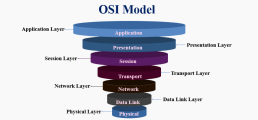Open Systems Interconnection (OSI) model is a framework for understanding how different network protocols and technologies work together to enable communication between devices. It was developed by the International Organization for Standardization (ISO) in the 1980s and has since become a widely-used standard for understanding and designing communication networks.
The OSI model consists of seven layers, each of which performs a specific function in the process of transmitting and receiving data:
Physical layer: The physical layer is responsible for transmitting the raw data bits over a physical medium, such as a fibre optic cable or copper wire. It defines the physical characteristics of the transmission medium, such as the type of cable and connector used.
Data link layer: The data link layer is responsible for providing error-free data transmission over a single link in a network. It divides the raw data transmitted at the physical layer into smaller units called frames and adds headers and trailers to each frame to enable error detection and correction.
Network layer: The network layer is responsible for routing data from its source to its destination over multiple links in a network. It provides logical addressing, which allows devices to communicate with each other regardless of their physical location.

Transport layer: The transport layer is responsible for ensuring reliable end-to-end communication between devices. It provides error-free transmission of data and ensures that data is delivered in the correct order.
Session layer: The session layer is responsible for establishing, maintaining, and terminating communication sessions between devices. It manages the exchange of data between devices and ensures that data is transmitted accurately and efficiently.
Presentation layer: The presentation layer is responsible for formatting and encoding data so that it can be transmitted and understood by different devices and applications. It translates data between different formats and encodings, such as ASCII and Unicode.
Application layer: The application layer is the top layer of the Open Systems Interconnection (OSI) model and is responsible for providing the interface between the network and the application software. It defines the protocols and standards that application software uses to access the network and transmit data.
The OSI model provides a standardized way of understanding how different network protocols and technologies work together to enable communication between devices. It is a valuable tool for designing and troubleshooting communication networks and understanding the functions and responsibilities of different protocols and technologies.
MANAGED CYBERSECURITY SOLUTIONS
Rhyno delivers a range of activities that combine to fully protect your infrastructure and data from cybercriminals, anywhere and everywhere, 24/7/365.
About Rhyno Cybersecurity Services
Rhyno Cybersecurity is a Canadian-based company focusing on 24/7 Managed Detection and Response, Penetration Testing, Enterprise Cloud, and Cybersecurity Solutions for small and midsize businesses.
Our products and services are robust, innovative, and cost-effective. Underpinned by our 24x7x365 Security Operations Centre (SOC), our experts ensure you have access to cybersecurity expertise when you need it the most.